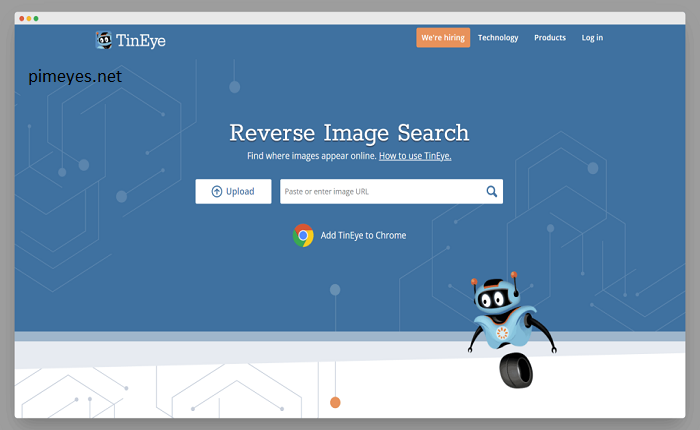
An AI reverse image search is a sophisticated process that leverages artificial intelligence to recognize, understand, and find information related to the image you upload or capture. Unlike traditional keyword-based searches, this innovative method leverages machine learning algorithms to comprehend the content and context of an image. With AI reverse image search, users can track image use online, find visually similar images in seconds, or identify objects, people and places.I noticed a trend for this technology due to its precision and versatility. Owing to its ability to facilitate automated and personalized communications, it has found applications in several industries, such as E-commerce, digital marketing, and research, to improve process efficiency.
How it Works AI Reverse Image Search
Reverse image search with AI works on advanced neural networks that have been trained to identify patterns and, shapes, and features of an image. It begins when a user uploads an image or pastes a URL. In contrast, AI examines elements of the image received, including color palettes, textures and objects — comparing them to an enormous database to find matches or visually similar imagery. At the core of the technology attached are convolutional neural networks (CNNs), a class of deep learning designs aimed to support image recognition. This involves breaking down an image into smaller pieces, allowing the AI to “view” and “understand” it. This rigorous process guarantees accurate and relevant outcomes, transforming AI reverse image search into a robust tool for personal and professional settings.
Using AI Reverse Image Search
Several use cases of reverse image search websites are changing the paradigm of how people and organizations leverage visual content. In e-commerce, it assists shoppers in finding items by transferring photos rather than describing them. In the same way, digital marketers use it to see where and how their images are being used online, protecting their intellectual property. AI reverse image search helps you obtain similar visuals or verify images’ authenticity in the academic and research field. Even social media companies apply this technology to advance user experience and identify aberrant content.
Advantages of AI-based Reverse Image Search
AI Reverse image search’s advantages are vast and influential. Firstly, it is time—and labor-saving because you do not need to describe what you want in detail. It lets users immediately see what they want with just an image upload. Another clear benefit of this tool is that you can discover visually similar content, which can be very useful for creatives and designers. Businesses can also use this tech to track the occurrence of their brand online and prevent it from being misappropriated. Additionally, thanks to AI reverse image search, the precision of results and speed are maximum, delivering accurate outputs in seconds. With its increasing adoption across various industries, its effectiveness in solving contemporary problems is surely acknowledged.
Problem with Reverse Image Search in
While it has many benefits, AI reverse image search also has challenges. One significant obstacle is guaranteeing privacy and safety, as people may be reluctant to upload sensitive images on unfamiliar platforms. Developers must include strong encryption and data security protocols to mitigate these risks. A further challenge is that AI models may have biases. Because these models are trained on specific datasets, they tend to fail on images that diverge from their training data and thus produce inaccurate images. These limitations can be mitigated through iterative training on a variety of datasets.
AI Reverse Image Search: The Future
The future of AI reverse image search is bright, with ongoing developments in machine learning and artificial intelligence shaping this technology. These tools will grow more potent as emerging technologies, including new generative AI and better image recognition algorithms, become available. We will also see more integration with augmented reality (AR) and virtual reality (VR) platforms, providing an even bigger step forward in user experiences. Moreover, with AI’s increased accessibility, reverse image search will become a built-in facility among devices and apps, bringing about another change in how we interact with visual material.
How to Use AI Reverse Image Search For Businesses
How businesses can leverage AI reverse image search to gain a competitive advantage. In retail, this technology can help you find products your customers need easily and improve shopping experiences. As a content creator, you can use it to track where your visuals are used and ensure brand consistency. AI reverse image search also has an essential role in market analysis. Understand the trends: Competitor analysis helps businesses to understand which trends are in and out of fashion and taste. You have this data, which drives data-driven decisions and perfectly makes strategies.
A Review of Popular AI Reverse Image Search Tools
There are several different AI reverse image search tools available today, each with its own unique offerings. Google Lens, for example, offers a near-instant UI and is plugged directly into Google’s massive database. TinEye is specifically designed to locate where an image has been used online, so it is best when tracking copyright. Others like Pinterest Lens and Bing Visual Search are designed for visual discovery and e-commerce. Users need to consider accuracy, speed, and how well a tool complements their work before deciding on one.
How AI Reverse Image Search Works in Real Life
AI reverse image search isn’t reserved for pros; it’s also a helpful tool for day-to-day users. Whether recognizing a plant, tracking down a recipe from a picture of food, or finding style inspirations, this technology makes everyday tasks easier. Its simple layout makes it easy for anyone to use, no matter their technical expertise.As an added benefit, AI reverse image search enables inclusivity by overcoming language barriers. Using visual data, users can access information without needing to enter a single word, which is accessible to individuals with varying backgrounds.
Conclusion
AI reverse image search — a groundbreaking technology altering how we deal with visual information. Its applications are limitless, from streamlining e-commerce to improving creative workflows. These changes will open the door for new ways to search visually, creating a more organic way to discover and find.
FAQs
What is AI·based on reverse image search? Image Search with AI is a technology that leverages artificial intelligence to analyze and retrieve an image-based search and provide exact and relevant results.
What is reverse image search, and how does AI reverse image search work? It works based on deep learning algorithms that recognize shapes, patterns, and features within an image and match them with an extensive database.
Benefits of AI reverse image search.? This can save time, increase accuracy, discover visually similar content, and be helpful in various domains such e-commerce, marketing, and research.
What are the limitations of AI reverse image search? These challenges include data privacy, biases in AI models, and accuracy with diverse datasets.
How can businesses use AI reverse image search to acquire new customers? Yes, Companies can utilize it in product discovery, copyright tracking, market analysis, and improving customer experiences.

